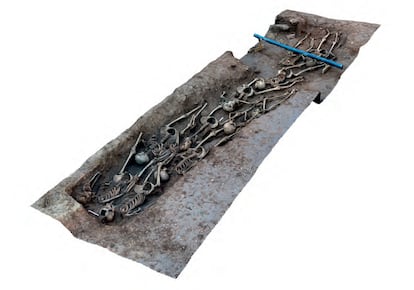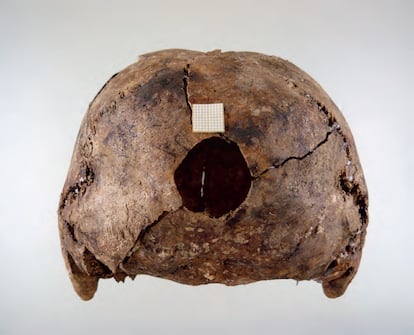Solving the mystery of a 200-year-old ambush
A new report reveals that 10 Napoleonic soldiers attacked by Spanish guerrillas were not sent to prison, as previously believed, but killed


In 2014, while repairing a water pipe that crossed the forest of El Carrascal in Unzué, Navarre, workers came across what looked like two human skeletons several centimeters from the surface. Specialists from the Civil Guard, the Navarre Institute of Legal Medicine and the Historical Heritage Service of the General Directorate of Culture of Navarre were called to the scene. What at first appeared to be a mass grave from the 1936-1939 Spanish Civil War, with the bones of the deceased showing the impact of bullets, in fact dated back to the confrontation between Napoleon Bonaparte’s French troops and Spanish guerrillas during the War of Independence (1808-1814). In the end, the skeletons of 10 people were unearthed.
The report Exhumation of a Mass Grave from the War of Independence in El Carrascal, published in the journal Navarre Archeological Works, begs the question: are these the same 10 Napoleonic soldiers who were captured in the forest by the guerrilla Javier Mina and taken to a castle in Lleida as history records, or were they killed as they surrendered? The experts Raquel Unanua from Runa Heritage Management, Lourdes Herrasti from the Aranzadi Science Society, Igone Etxeberria from the Donostia University Hospital and Francisco Etxeberria, from the University of the Basque Country, believe they have solved the mystery.

After the brutal and unexpected Napoleonic invasion of Spain, “in Navarre, as in other regions, the guerrilla strategy was implemented to develop armed resistance, playing the same role throughout the conflict, which was harassing the enemy, attacking all kinds of convoys, intercepting correspondence, and spreading resistance to the occupation,” the researchers point out. Guerrilla actions began at the end of 1808, after the French occupation, and the defeat of General Francisco Javier Castaños in Tudela, on November 23, 1808, which was followed by the capture of Zaragoza in February 1809. Their modus operandi revolved around working in small groups that managed to blend into the landscape and surface in unexpected locations to execute ambushes.
Among the first guerrillas in Navarre were the Mobile Riflemen of Andrés Eguaguirre, appointed by the laureate José Palafox. However, he was dismissed on account of his lack of discipline, haughtiness, and insolence and it would be Javier Mina, nicknamed “The Student” (1789-1817), who organized the armed resistance, creating in July 1809 the guerrillas of Corso Terrestre, with the support of the military authorities.

Initially composed of 12 men, it ended with more than a 1,000 guerrillas — mostly farmers, artisans, servants, soldiers, churchmen, students, foreigners and deserters from the French army. Its radius of action included the Camino Real de Pamplona, the city of Tafalla and the forest of El Carrascal. The Corso Terrestre remained active between 1809 and 1810, until Mina was arrested and sent to France. The historian Francisco Miranda recalls that on August 12, 1809, Mina carried out an ambush in El Carrascal with 12 men on 10 French artillerymen, “whom he captured and transferred to Lleida.”
According to the memoirs of Mina’s uncle, the soldier Francisco Espoz y Mina, “Mina and his men had emerged from their hiding place and threw themselves on the gunners with such fury, it was not even necessary to shoot the 10 enemies — because there were 10 of them — who gave up their weapons and surrendered.”
The researchers’ report points out that “the heroic nature of this episode does not detract from a certain comparison with the discovery of the mass grave, coinciding with the number of individuals, the space and the place. But the account of the facts contradicts the finding itself: a simultaneous burial of 10 individuals whose anthropological study establishes that they all have gunshot wounds, distributed throughout the body, both on the front and back, indicating an ambush in which the French soldiers were surprised by the rapid attack.”
According to the anthropological study, the 10 dead were aged between 16 and 25 and had been shot a total of 22 times, with six bullets in the back. Four of the muzzleloaders, which were inserted through the muzzle of the weapon, have been located.
Specialists have “as an initial hypothesis, in terms of probability, the possibility that it is one of the first actions carried out by the Corso Terrestre guerrillas under the command of Javier Mina, on August 12, 1809, with the ambush of 10 French artillerymen.” They recall that the “few references to this action indicate that they were not attacked with firearms, rather they were arrested when they surrendered and sent to Lleida, so it would not fit the paleopathological analysis of the find [they all show bullets, even in the skull].” However, “the coincidence regarding location and number of people killed, and the indeterminacy offered by documentary sources means this option remains open.”
The researchers go on to conclude: “Due to the order in the deposition [buried all together and in a linear fashion] and their location close to the road, very close to where the events took place, they were possibly buried by the residents of the area and not by the perpetrators.” These civilians possibly took pity on them, although they stripped them of their possessions. It was, after all, a time of war.
Sign up for our weekly newsletter to get more English-language news coverage from EL PAÍS USA Edition
Tu suscripción se está usando en otro dispositivo
¿Quieres añadir otro usuario a tu suscripción?
Si continúas leyendo en este dispositivo, no se podrá leer en el otro.
FlechaTu suscripción se está usando en otro dispositivo y solo puedes acceder a EL PAÍS desde un dispositivo a la vez.
Si quieres compartir tu cuenta, cambia tu suscripción a la modalidad Premium, así podrás añadir otro usuario. Cada uno accederá con su propia cuenta de email, lo que os permitirá personalizar vuestra experiencia en EL PAÍS.
¿Tienes una suscripción de empresa? Accede aquí para contratar más cuentas.
En el caso de no saber quién está usando tu cuenta, te recomendamos cambiar tu contraseña aquí.
Si decides continuar compartiendo tu cuenta, este mensaje se mostrará en tu dispositivo y en el de la otra persona que está usando tu cuenta de forma indefinida, afectando a tu experiencia de lectura. Puedes consultar aquí los términos y condiciones de la suscripción digital.
More information
Archived In
Últimas noticias
Most viewed
- Reinhard Genzel, Nobel laureate in physics: ‘One-minute videos will never give you the truth’
- Oona Chaplin: ‘I told James Cameron that I was living in a treehouse and starting a permaculture project with a friend’
- Pablo Escobar’s hippos: A serious environmental problem, 40 years on
- Charles Dubouloz, mountaineering star, retires at 36 with a farewell tour inspired by Walter Bonatti
- Why we lost the habit of sleeping in two segments and how that changed our sense of time










































